Matador Network's Blog, page 56
April 3, 2025
Inside Tskaltubo, Georgia: the Abandoned ‘wellness Resort’ About to Change Forever

As we approached the grand facade of the abandoned sanatorium, we could hear music echoing through the building and see a clean-up crew sweeping confetti and stacking chairs in the columned entrance hall. Further in, the star of the day — a bride with waist-length brown curls — posed in her wedding dress at the top of a stone staircase. Her train cascaded down the steps, turning shades of gold by the brightly setting sun. Occasionally, the groom was even invited into the pictures.
It was the scene at Hotel Medea, also called “Sanatorium Medea,” in Tskaltubo, in the country of Georgia. Though it was officially abandoned for decades, it never stopped buzzing with life. Locals and tourists alike used it as a hangout, an Instagram backdrop, and, yes, even a wedding venue.

Photo: Mikhail Starodubov/Shutterstock
It seemed romantic, and my partner and I walked through the vast columned hallways, up crumbling staircases, and onto a rooftop terrace. From this high vantage point, we could take in the full scale of the building. The structure formed a massive rectangle around a courtyard, with four wings stretching to the sides. In the courtyard below, a once-grand swimming pool sat overgrown with bushes.
Just one abandoned building of this scale would thrill any urban explorer, or “urbexer” — people who enjoy exploring abandoned and off-limits places. There are more than two dozen such buildings scattered through Tskaltubo, a small town in Georgia, a country sandwiched between Russia and Türkiye. I’d spent five days exploring Tskaltubo, but still hadn’t seen it all.
It’s a special place where still-abandoned buildings have been reclaimed as community spaces, though they may not function as that for much longer. Renovation projects are underway, and soon, many of the atmospheric ruins will be transformed — or lost — forever.

Photo: Shutterstock/BGStock72
Tskaltubo sits atop bubbling hot springs once famed across the Soviet Union. A direct train from Moscow brought visitors to bathe in radon-rich thermal waters, believed to relieve rheumatism and inflammation. Most resorts opened in the 1920s.
In 1931, the Georgian Soviet Republic designated it as an official “balneotherapy center,” and the town quickly transformed into one of the most prestigious health resorts in the Communist Bloc. More than 20 wellness resorts called sanatoriums were built to combat chronic illnesses like psoriasis and arthritis, complete with spas, theaters, libraries, and conference halls. By the 1950s, Tskaltubo was drawing up to 125,000 visitors annually. Joseph Stalin allegedly visited in 1951 to treat an ongoing case of rheumatoid arthritis in his leg, though records on his visits are sparse.

Photo: Fotokon/Shutterstock
Tskaltubo wasn’t just for the elite, though. Some resorts were named after the workers they served, such as Sanatorium Metallurgist, named for the steelworkers and miners it catered to, known as metallurgists. Under the Soviet constitution, laborers had a right to “rest and leisure.” It allowed doctors to issue all-expenses-paid vouchers for two-week stays in Tskaltubo, where patients received treatments ranging from hot spring baths to electrotherapy.
Then, in 1991, the Soviet Union collapsed. The resorts shut down, tourism disappeared, and Tskaltubo became a quiet farming town, its once-grand buildings left to decay. It’s been described as a ghost town during those years, but the term doesn’t quite fit, as Tskaltubo’s sanatoriums have never been entirely empty.
After the 1992 Abkhazia conflict in the country displaced more than 200,000 Georgians, around 10,000 refugees found shelter in the abandoned buildings. It was supposed to be a temporary housing solution, but many families ended up living there for decades. People died and were born in the former sanatoriums. It’s only in the past couple of years that most of those Abkhazian refugees have been rehoused in formal apartment blocks.
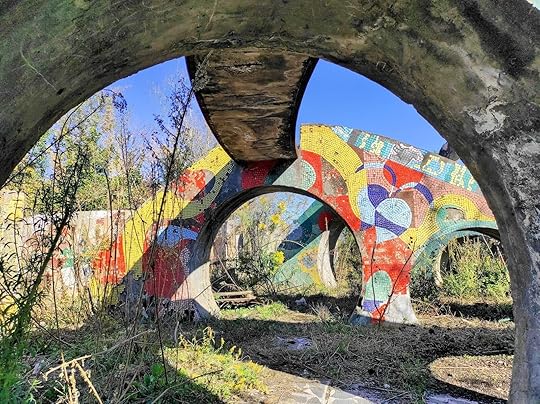
Photo: Eloise Stark
Locals claimed the emptied resorts in other ways, too. During the 2020 parliamentary elections, some buildings were used as polling stations; you can still see the Covid-era stickers to ensure social distancing between voters. There are unofficial gatherings, too. In daytime, you’ll see couples seeking out secluded corners, and groups of teenagers hanging out, chatting and taking photos. Empty beer bottles and murals of varying artistic quality mark the late-night festivities that have taken place within these walls.
In recent years, Tskaltubo has also attracted international visitors, as tourism to the country of Georgia has grown. According to the National Statistics Office of Georgia, there were 7.4 million international visitors in 2024, up 4.2 percent compared to the previous year and 32 percent compared to a decade earlier. Now, the town has become well-known as one of the world’s top urbex destinations. Travelers have become a regular sight in the abandoned sanatoriums, alongside people from the surrounding town and those families who have made the buildings their home.

Photo: Lucas M. Kaiser/Shutterstock
With tourism growing in Georgia, Tskaltubo is changing. The government’s “New Life for Tskaltubo” plan, launched in 2022, is designed to transform it into a “modern, world-class” spa town. Investors from Georgia, Egypt, Qatar, and beyond have purchased several of the former resorts, closing them off to visitors. Modern renovations are underway on a handful of them.
The plan’s vision is clear: a luxury wellness destination catering to affluent travelers. Opponents of the plan are concerned that the high prices the resorts will likely charge will make the resorts financially inaccessible to locals. A night at Tskaltubo Legends Resort, a spa that reopened in 2011, costs $80 — a steep price in a country where the average monthly salary is under $800.
But something more than just affordability is at stake. Privatizing these buildings will put an end to Tskaltubo’s unique community spaces, which act as a strange “third space” by being neither operational, nor entirely abandoned. What follows may be luxurious, but might never hold the same magic as these palatial buildings that belong to everyone and no one at the same time.

Photo: Eloise Stark
Tskaltubo is arranged around a central park that’s home to several bathhouses and a natural spring fountain where visitors can put their hands under the roughly 93-degree F, mineral-rich water. The resorts are scattered throughout town and are close enough to one another to easily explore on foot. There are several dozen abandoned buildings, but some are more interesting than others.
Visiting Tskaltubo’s empty sanatoriums is generally legal, as many are situated on publicly accessible land. However, properties acquired by private investors are often secured with fences and may have restricted access.
The largest building in Tskaltubo’s central park is Spring 6 (formerly Bathhouse No. 6), one of the rare Soviet-era spas that never closed in Tskaltubo. It’s a great place to go for a soak after the dusty business of exploring the empty buildings. Visitors can book a variety of traditional and more unexpected wellness treatments, from sports massages to speleotherapy (breathing inside a cave) to electroshock therapy. Treatments are available to book online or in person.
Bathhouse No. 8
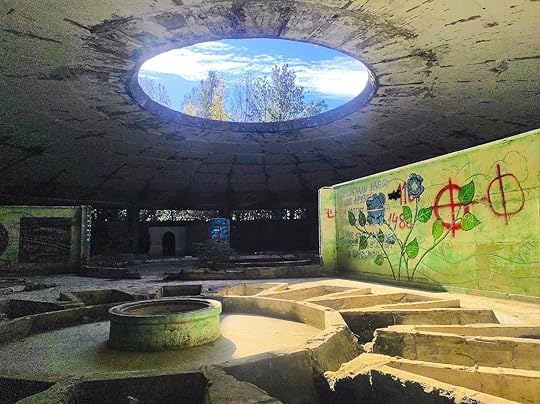
Bathhouse 8 in Tskaltubo, Georgia. Photo: Eloise Stark
A masterpiece of brutalist architecture, this former public spa resembles a concrete UFO that landed in the middle of the park. Inside, under a rounded roof, individual baths are arranged like petals around central fountains. On the algae-covered walls, you can still make out nature scenes, including dancing deer. Sunlight streams through a circular hole in the roof, casting dramatic shadows. Today, it’s a popular hangout, and the walls are covered in street art.
Once reserved for steelworkers and miners, Sanatorium Metallurgist is one of the best-preserved sites in Tskaltubo, with ornate original features throughout. The wow factor begins in the main entrance hall, where a massive chandelier hangs from a ceiling adorned with intricate moldings.
Visitors can explore an old library, doctors’ offices, and even a theater, where a crumbling grand piano still stands. On the second floor, keep an eye out for the pink and blue elevators — one for ladies, the other for gents. Around the back of the building is a stunning glass atrium, where a single tree grows from a crack in the concrete floor.

Medea Sanitorium in Tskaltubo, Georgia. Photo: Eloise Stark
One of the most photographed sanatoriums, Medea’s grand facade of columns and arches makes it a favorite for weddings. Inside, visitors can climb sweeping staircases to reach the roof terrace which overlooks the courtyard. The inner hallways are also interesting, inhabited until recently by Abkhazian refugees. Today, you can find reminders of their presence, including posters on the walls, discarded clothes and toys, and even family photos.
Mosaics were widely used in Soviet-era art and architecture, and this children’s playground is one of the finest examples left in Georgia. Stark geometric patterns form a climbing frame, adorned with colorful tiles that depict human figures, plants, and animals, including giraffes and bison.
Sanatorium Imereti
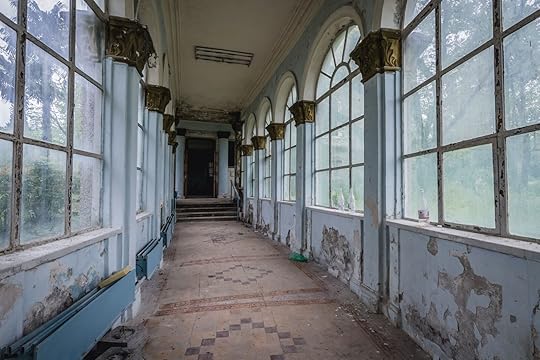
Photo: Fotokon/Shutterstock
A stray dog appointed himself as my guide when I visited Sanatorium Imereti. Much of the building is inaccessible, but what remains is breathtaking. It led me first through a field of wildflowers, where I stumbled across a rotunda with arched doorways. Inside, blue paint peeled from the walls, revealing intricate moldings still remarkably intact.
From the rotunda, I followed my four-legged companion into the main building, through columned hallways, up grand staircases, and into an abandoned theater. But at one point on an upper floor, where gaping holes in the floorboards revealed the rooms below, he refused to go any further. If you decide to explore this beautiful spot, proceed with extreme caution.
Tskaltubo is 14 miles from Kutaisi International Airport, which connects to major cities in Europe and the Middle East. Car rentals and taxis are readily available at the airport for a quick transfer to town.
Alternatively, you can visit Tskaltubo on a day trip on an organized tour from Kutaisi or even Tbilisi, Georgia’s capital (about a 3.5-hour drive away). Companies like Budget Georgia or Friendly Tours offer one- and two-day options.
Tskaltubo is a small town of around 7,000 people and has most of the facilities you would need for a short stay. There are hotels, restaurants, cafes, supermarkets, and ATMs that accept international cards. However, some restaurants only take cash, so it’s best to come prepared.
When visiting, be mindful of residents. Some of the abandoned sanatoria are still inhabited. Always respect people’s personal space and avoid entering private apartments. Never take photos of homes without permission. Most residents are accustomed to visitors exploring the sanatoriums, but a little consideration goes a long way in maintaining good relationships.

Photo: BGStock72/Shutterstock
The golden rule of urban exploration is to leave everything how you found it. Don’t take any of the objects you find as souvenirs, don’t force entry into locked buildings, and don’t damage anything. And, of course, prioritize safety. If a structure looks unstable, don’t take the risk.
The safest way to explore the abandoned buildings is to hire a guide for the day. You’ll not only benefit from knowing what areas are safe to explore, but also get insight into their local knowledge of the town’s history and current events. 
April 2, 2025
The Best Airbnbs in Liverpool to Explore the City

Liverpool is an exciting maritime city in the northwest of England sitting on the banks of the River Mersey. Immortalized for being the birthplace of The Beatles and for its two Premier League football clubs, Liverpool and Everton, the Merseyside seaport is also a treasure trove for artistic and architectural delights. Take a stroll along the Royal Albert Docks to see iconic landmarks including the Three Graces and the Tate Liverpool. The nightlife and dining scene isn’t half bad either; you’ll find the edgiest eateries in the Baltic Triangle and the coolest music venues in Ropewalks.
Live like a Premier League striker or rockstar at these top-rated Airbnbs in Liverpool close to music venues, pubs, and the docks.
Traveling to the United Kingdom? Check out Matador’s UK accommodations guides: The Best Airbnbs in Manchester, From a Luxury Yacht To a Renovated Bank Vault 23 Airbnbs in London’s Trendiest Neighborhoods Top 13 Airbnbs for Exploring the Whole of Scotland The Most Convenient Hotels To Experience Manchester, England The 8 Best Hotels in Edinburgh Close To the Must-See Sights The Top Glasgow Airbnbs Across the City’s Coolest Neighborhoods
We hope you love these Airbnb Liverpool vacation rentals! Just so you know, Matador may collect a small commission from the links on this page if you decide to book a stay. Listed prices are accurate as of the time of publication.
Penthouse with the best views in town Photo: Airbnb
Photo: Airbnb Photo: Airbnb
Photo: Airbnb Photo: Airbnb
Photo: Airbnb Photo: Airbnb
Photo: AirbnbSee more photosThis duplex Airbnb in Liverpool has a private wraparound terrace with skyline views. Wall-to-wall windows allow natural light to flood the living room and principal bedroom while the kitchen is meticulously stocked for those planning on cooking at home. The apartment is a five-minute walk from Liverpool Central Station and Royal Albert Dock. For those traveling by car, the rental includes one secure parking space.
Six guests, two bedrooms
Price: $478 per night
 Photo: Airbnb
Photo: Airbnb Photo: Airbnb
Photo: Airbnb Photo: Airbnb
Photo: Airbnb Photo: Airbnb
Photo: AirbnbSee more photosLeave your rental in its allotted parking spot and explore the Merseyside city on foot from this renovated coach house in its most sought-after neighborhood. The space benefits from high ceilings, a chic kitchen with a breakfast bar, and two comfortable guest rooms. The property is next to St Luke’s Bombed Out Church and within walking distance of the Georgian Quarter’s beloved cafes and bistros.
Five guests, two bedrooms
Price: $148 per night
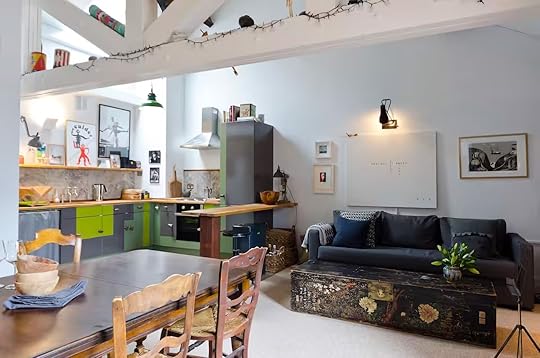 Photo: Airbnb
Photo: Airbnb Photo: Airbnb
Photo: Airbnb Photo: Airbnb
Photo: Airbnb Photo: Airbnb
Photo: AirbnbSee more photosThis handsome apartment is kitted out with a mix of vintage gems and modern appliances, providing the perfect marriage of comfort and practicality. Liverpool ONE, Ropewalks, and Royal Albert Dock are all within walking distance and there is one parking permit available for guests. Additional guests may sleep on the sofa although this rental is most suited to couples. Remote workers will appreciate the speedy Wi-Fi.
Four guests, one bedroom
Price: $123 per night
 Photo: Airbnb
Photo: Airbnb Photo: Airbnb
Photo: Airbnb Photo: Airbnb
Photo: Airbnb Photo: Airbnb
Photo: AirbnbSee more photosThis ultra-central Airbnb is convenient for exploring Liverpool’s waterfront, city center attractions, and football stadiums. The kitchen has a coffee maker (plus a bean grinder!) as well as all the necessary amenities for home cooking. There’s a chunky modular couch and a TV rigged with Netflix and Sky Sports for shaking off a heavy night out in Ropewalks and a desk for those working from the road.
Four guests, two bedrooms
Price: $215 per night
 Photo: Airbnb
Photo: Airbnb Photo: Airbnb
Photo: Airbnb Photo: Airbnb
Photo: Airbnb Photo: Airbnb
Photo: AirbnbSee more photosThis Victorian townhouse has six individually designed bedrooms, a gourmet kitchen and dining room, two lavish bathrooms, and a games room. It’s the perfect base for resting and family bonding in between seeing the countless sights of Merseyside. Just south of the city center, the rental is convenient for the Baltic Triangle, Georgian Quarter, and Sefton Park. The host also offers a luxury car service if required.
Twelve guests, six bedrooms
Price: $1,261 per night
 Photo: Airbnb
Photo: Airbnb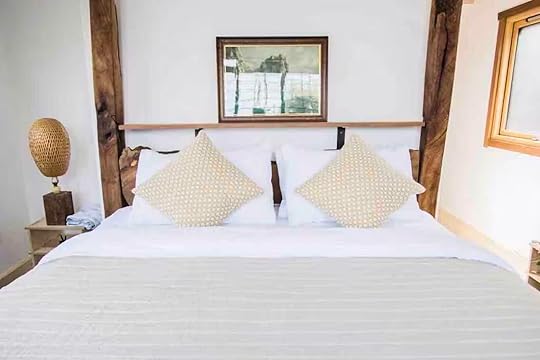 Photo: Airbnb
Photo: Airbnb Photo: Airbnb
Photo: AirbnbSee more photosThis houseboat Airbnb in Liverpool invites you to stay on a unique larchwood vessel on the city’s historic waterways. Inspired by Japanese craftsmanship, this stylish barge has high ceilings and a bedroom overlooking the water. The bow terrace is especially beautiful at sunset and the boat is heated for four-season comfort. There is a lovely restaurant in the marina and the Baltic Market is a short walk from the community.
Three guests, one bedroom
Price: $216 per night
 Photo: Airbnb
Photo: Airbnb Photo: Airbnb
Photo: Airbnb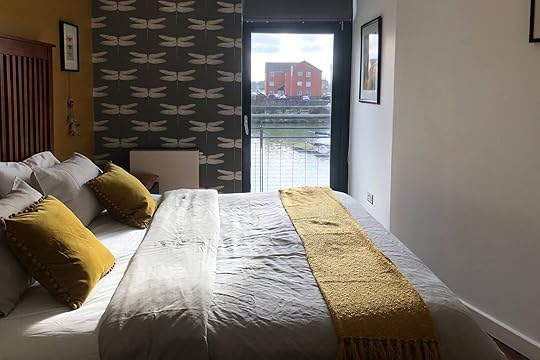 Photo: Airbnb
Photo: Airbnb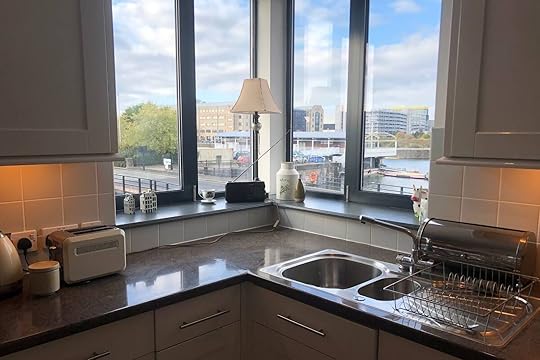 Photo: Airbnb
Photo: AirbnbSee more photosHow about dockside living but from the comfort of a brick-and-mortar house? This two-bedroom condo at the marina has water views and a private balcony. It’s cheerfully appointed with modern art, homely furnishings, and a well-equipped kitchen. The host is applauded for her thoughtfulness and special touches. To round things off, secure parking is included and dogs get to stay for free.
Four guests, two bedrooms
Price: $303 per night
 Photos: Airbnb
Photos: Airbnb Photos: Airbnb
Photos: AirbnbSee more photosThis Guest Favorite Airbnb has the whole package: cool decor, top-notch amenities, and a central location in Liverpool. It’s part of the Liverpool ONE development where you’ll find a variety of cultural, dining, and shopping attractions. Although sparsely decorated, the apartment stuns with its exposed red brick walls and sapphire-accented kitchen. Check-in is streamlined with a Smart Lock and the host is responsive to messages.
Four guests, one bedroom
Price: $235 per night
 Photo: Airbnb
Photo: Airbnb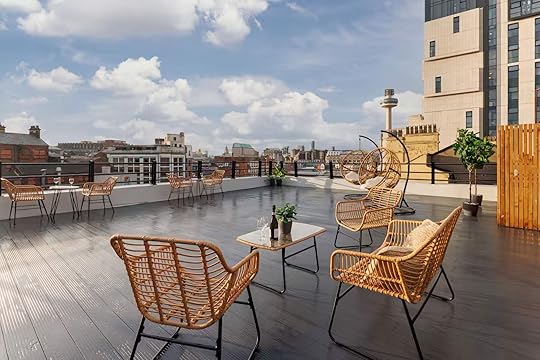 Photo: Airbnb
Photo: Airbnb Photo: Airbnb
Photo: Airbnb Photo: Airbnb
Photo: AirbnbSee more photosThis dreamy duplex for rent is close to Liverpool Lime Street Station and convenient for the main sights. The lower level accommodates the kitchen and lounge while the bedroom and bathroom are upstairs. Note that these floors are linked only by a spiral staircase. You’ll have exclusive access to a private rooftop terrace shared between residents during your stay.
Two guests, one bedroom
Price: $292 per night
 Photo: Airbnb
Photo: Airbnb Photo: Airbnb
Photo: Airbnb Photo: Airbnb
Photo: Airbnb Photo: Airbnb
Photo: AirbnbSee more photosBook this stylish heritage house if you’ve scored soccer or concert tickets in Liverpool – Anfield Stadium is a two-minute walk from the door! The home has been remodeled while retaining the essence of the Victorian era through its design. It has two doubles and one single bedroom turned out with boutique finishings and luxurious quilts. The location is also handy for family outings to Knowsley Safari Park and Crosby Beach.
Five guests, three bedrooms
Price: $468 per night
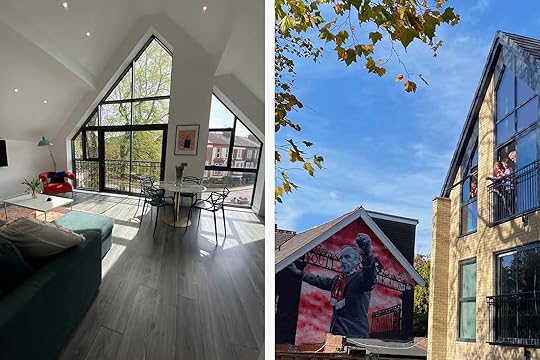 Photos: Airbnb
Photos: Airbnb Photo: Airbnb
Photo: AirbnbSee more photosThis immaculate modern apartment is operated by a boutique hotel and provides the comforts of both accommodation types. It has a roomy lounge with huge windows overlooking this peaceful residential area and two reasonably sized bedrooms. The location is excellent for Anfield and Everton stadiums but equally convenient for those planning road trips to Manchester and Blackpool.

Four guests, two bedrooms
Price: $189 per night
Staying at an All-Inclusive Resort in Cancun: What First-Timers Need to Know, Resort Rules, and Recommendations

All-inclusive resorts are a fantastic way to worry-free on vacation. With almost everything paid beforehand, you can enjoy unlimited food and alcohol (including in-room mini bars and snacks), sunny days at the beach, relaxing pools, daily activities, nightly entertainment, spacious lodging, and excellent service without reaching for your wallet at every turn. And there’s no greater selection of commendable resorts than in and around Cancun, Mexico—the all-inclusive capital of the world.
Understanding the basics of all-inclusive resorts
Photo: M-Production /Shutterstock
Having stayed at nearly two dozen all-inclusives over the last decade, I’m happy to report that they are, fortunately, mostly “inclusive.” There’s no shortage of included things to do, from nightly entertainment and non-motorized water sports, to on-site guided activities and more pools, music, and beaches than you’ll likely be able to enjoy. Or if you’re like me, you can choose to do absolutely nothing in some of the most relaxing and care-free settings you’ll find anywhere.
That said, there are some things that aren’t typically included at all-inclusive resorts. While bars, restaurants, and self-service food options include gratuities, wait staff expect cash tips for poolside, beachside, or room service deliveries. Premium liquor (which some resorts charge extra for or reserve for guests who upgrade to club status), select specialty restaurants or entrees, and childcare outside of free daily kids club hours also cost extra. Furthermore, there typically are surcharges for spa treatments, motorized water sports, off-site excursions, and airport transports.
To get the most of these resorts, however, there are some tips you should follow. For example, book dinner reservations early if you want to guarantee access to non-buffet restaurants. Like a cruise, order as much as you like but only swallow what you love. For best results (and potentially maximum weight gain), I recommend progressive dining at several restaurants, bars, cafes, dessert shops, and the buffet throughout the day.
As of 2024, you can now book Ubers to avoid the previously expensive ground transportation and taxis at Cancun International Airport. But you still shouldn’t drink the water, which is why most resorts provide in-room bottles to stay hydrated. If this sounds like your type of vacation, where’s a good place to start? Depending on your preferences, you can’t go wrong with one of these reputable resorts.
Hilton Cancun / Mar Caribe – best for families, foodies, spa, and beach goers
Photo courtesy Hilton Mar Caribe
Hilton has made a big push into all-inclusives in recent years and owns two of the best resorts within 15 minutes from Cancun International Airport. Located in the hotel district, Hilton Mar Caribe is home to one of the nicest stretches of beach in the entire area. Its classic, timelessly inviting, teal blue Caribbean surf is stunning and a perfect spot for beach goers and families alike. The lively pools and swim up bars are plenty. And the property’s zen-inducing spa and bamboo hydrotherapy jungle offer true tranquility.
But for me, Hilton Mar Caribe’s food is the real highlight. In addition to generous portions of fresh guacamole, mangoes, and phenomenal produce wherever you go, the included Mexican, Italian, Asian, and Steakhouse restaurants are all fantastic. So is the 24-hour cafe and buffet. In fact, the latter morphs into a Mexican Mariachi festival and full Brazilian rodizio twice a week, replete with table service and swords of mouthwatering meats—something I’ve never experienced at any all-inclusive buffet before.
If you want a more vibey Hilton with the same standout restaurants and food, better architecture and rooms, but slightly less appealing beach, consider Hilton Cancun to the south. It’s calmer and more secluded, although still close to the airport.
Excellence Riviera Cancun – best for romance, relaxing pools, serene landscapes
Photo courtesy Excellence Riviera Cancun
There’s a lot to love about Excellence Riviera Cancun, much of which is noted in its thousands of excellent guest reviews. Chief among them: it’s an adult-only oasis filled with pristine palms, perfectly manicured gardens, and more fantastic, clean, and abundant pools than I can count. During a recent stay, my wife and I seriously found our happy place on consecutive sunny days in secluded cabanas, ample seating, dreamy beaches, and our patio hot tub.
We also adored the hacienda-style covered walkways and restaurants, especially the al fresco Mexican cantina. The resort was a little sprawling and disorienting the first couple of days, but we grew to appreciate the long walks as we made our way around the resort. Excellence also starred our favorite nightly entertainment, in an open air stage with tasteful musicians and performers.
At over 20 years old, our spacious suite was dated, but it was also immaculate and stocked with the best mini- and snack-bars, full-bottled spirits, nightly desserts, and room attendants of any resort I’ve stayed at recently. While the beach was fantastic, sadly seaweed took over the surf during our visit. But otherwise Excellence is known for being one of the most well-maintained resorts in Cancun and just 20 minutes from the airport.
Marriott Cancun, An All-Inclusive Resort – best for overall value, desserts, loyalty program
Photo courtesy Marriott Cancun
The world’s largest hotelier was late to the all-inclusive game after converting one of its previous a la cart Cancun hotels into the company’s first all-inclusive last year. That’s good news for Marriott loyalists, as it lets them use wide-ranging reward points for all-inclusive stays. When coupled with competitive promotions, this makes Marriott Cancun, An All-Inclusive Resort a great overall value while still retaining its upscale resort amenities.
While I enjoyed the renovated architecture, my ocean view balcony room, and the relaxing pools and beach huts, Marriott was still working out some service kinks during my recent stay. While the staff were always excellent, the dining was uneven. Outside of the Mexican restaurant and desserts, which combined were some of the best of any resort I’ve visited, there was little else worth writing home about. It was by no means bad. Just not as exciting as other resorts when I visited.
Would I go back though? Definitely. Marriott Cancun is a great resort with a lot of upside.
Also consider: Grand Fiesta Coral Beach. It’s been a few years since I stayed, but this big pink resort is Mexican-owned and operated and a lot of fun (not to mention delicious) to boot. 
New Flights From United Airlines Make It Easier Than Ever to Reach Thailand, Vietnam, Australia, and the Philippines

United Airlines is expanding its number of cross-Pacific routes with four new destinations in Thailand, Vietnam, the Philippines, and Australia: Bangkok, Ho Chi Minh City, Adelaide and Manila. This brings United’s total number of Pacific destinations to 32, four times that of any other airline based in the United States.
This strategic expansion comes when questions are arising about travel demand, but show that there’s still room for increased transportation options in certain markets.
Beginning October 26, United will launch daily one-stop flights to Bangkok and Ho Chi Minh City — a first for any US airline. The routes will be operated via Hong Kong using Boeing 787-9 Dreamliners. The flights will depart from Los Angeles and San Francisco, feeding into United’s existing morning and evening departures at Hong Kong.
Starting December 11, United will become the first airline to operate nonstop flights between the US and Adelaide, a press release states. The new three-times-weekly service will run seasonally from San Francisco aboard the Boeing 787-9.
Adelaide has long lacked nonstop or even one-stop service to North America, despite growing tourism interest in its Barossa Valley wine region and proximity to destinations like Kangaroo Island. With this addition, United will serve four cities in Australia, cementing its role as the leading airline between the continental US and Australia.
United will also double its service to the Philippines. A second daily flight between San Francisco and Manila is scheduled to begin October 25. The additional frequency offers both daytime and evening departure options in both directions, responding to increased demand from both the Filipino diaspora and a growing tourism market.
United remains the only US airline with service to the Philippines, with flights to both Manila and Cebu.
Tickets for Adelaide and the second Manila flight are already available, while bookings for Bangkok and Ho Chi Minh City will open at a later date. 
The Garden State Goes Global: Inside New Jersey’s International Eats

Popular conceptions of New Jersey’s food scene probably include submarine sandwiches, greasy spoons, and the state’s take on the classic American diner — a place where “disco fries,” Jersey’s answer to poutine, has been immortalized. However, in-the-know gourmands know the Garden State holds true to its name and is home to formidable wineries and many farm-to-table restaurants serving fresh New American fare.
New Jersey is also one of the most diverse states in the US, and this ethnic diversity certainly broadens its dining scene. There’s a vast spectrum of restaurants dishing out international cuisines, spanning Portuguese, Middle Eastern, East Asian, Latin American, Italian, South Asian, and more. Truly, whatever you’re craving, New Jersey’s got it — here’s where to find it.
The Ironbound: New Jersey’s Little Portugal and beyond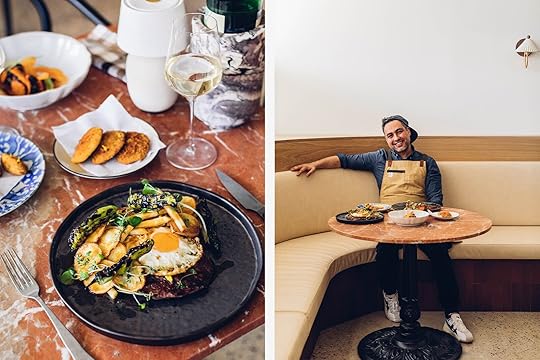
Photos: Emily Schindler/Lita
Campino Restaurant: 70 Jabez St, Newark, NJ 07105
Lita: 1055 NJ-34, Aberdeen Township, NJ 07747
In eastern Newark near the main train station lies the Ironbound, a neighborhood named for the railroad tracks that converge there. It’s not the iron tracks that New Jerseyans think of when the neighborhood comes up in conversation, though. It’s Portuguese food. Hence the nickname “Little Portugal.”
Historically, the Ironbound has been a community of immigrants, especially Portuguese. At Campino, a beloved traditional Portuguese restaurant since 1982, you’ll find classics like medalhões de porco molho bulhão pato (pork loin medallions served bulhão pato-style with clams and herbs) and mariscada molho (seafood stew) in a tomato-based red or parsley-forward green sauce. For the quintessential Portuguese dish, order the bacalao (salt cod) served either grilled with potatoes, onions, and peppers or in a cream sauce.
Portuguese gastronomy also exists outside of the Ironbound, particularly at Lita in suburban Aberdeen Township. There, acclaimed Chef David Viana combines his culinary talent and his Ironbound roots to elevate Portuguese staples. Viana has been featured on the Food Network and is a 2025 James Beard Semi-Finalist for Best Chef Mid-Atlantic.
Collingswood: Lebanon’s culinary embassyLi Beirut: 619 Collings Ave, Collingswood, NJ 08107
Collingswood may seem like simple suburb of Philadelphia on the New Jersey side of the Delaware River, but for one family, it became a refuge. Escaping war, Chef Patricia and her husband Tony Massoud fled from Beirut to the US several years ago, settling in New Jersey to continue raising their three children. The resilient family has kept their spirits up — along with their passion for Lebanese cuisine and hospitality — at their restaurant, Li Beirut.
The menu goes beyond the usual pan-Middle Eastern fare of falafels, dips, shawarma, and grilled meats. One example of the restaurant’s authentic Lebanese dishes is its rendition of hummus, topped with morsels of beef and finished with pine nuts for an added dimension of flavor and texture. You’ll also find lahme ba’ajine — a sort of Lebanese pizza with tomatoes, onions, mushrooms, bell peppers, olives, herbs, and spices on a crispy crust — as well as mouhammara, a roasted red pepper dip with walnuts and pomegranate molasses that walks a line between spicy and sweet.
Hackensack: Unapologetically SichuanHot Fish: 450 Hackensack Ave #6, Hackensack, NJ 07601
Chinese takeout has become a go-to American comfort food, but at Hot Fish in Hackensack, you won’t find the Americanized General Tso’s chicken on the menu. The sister restaurant to Michelin-recommended Chuan Tian Xia in New York City, Hot Fish hones in on China’s Sichuan province, known for spicy cuisine and seafood (hence the restaurant’s name).
Newcomers to Sichuan cuisine should enjoy the classic dish mapo tofu — tofu and ground pork, made spicy with Sichuan peppercorns, which leave a tingly feeling in your mouth. The more adventurous foodie will love the restaurant’s authentic offerings like green pepper numbing fish or spicy dry pot with frog.
Long Branch: Down the shore in El Salvador
Photo: Tanya Green/Asbury Park Press/Don Beto’s
Don Beto’s Comida Salvadorena: 20 Memorial Pkwy, Long Branch, NJ 07740
Latin American food is ubiquitous in the Hispanic enclaves closer to the Hudson River, but head down the shore for a taste of El Salvador. At casual eatery Don Beto’s in Long Branch, sit indoors or outside at a picnic table on a nice day for Salvadoran classics, including hearty soups or chicken rolled into a tamale and steamed in a banana leaf.
The biggest draw at Don Beto’s is the pupusas, El Salvador’s national dish — thick, pan-fried tortillas stuffed with beans, meat, vegetables, and/or cheese, including queso con loroco, which is blended with a savorous herb derived from a flower bud that’s native to Central America. For dessert, indulge your sweet tooth on a Salvadoran empanada filled with bananas and sweet cream, or try the nuegados (yucca fritters smothered in a honey sauce).
Edison: A subcontinental taste of IndiaBombay Blue Indian Bistro: 1963 Oak Tree Rd, Edison, NJ 08820
Edison, NJ, and its neighboring communities are home to one of the country’s largest immigrant populations from the Indian subcontinent. With that community comes a discernment for authentic cuisine, and bustling Indian bistro Bombay Blue has risen as a crowd pleaser.
Though the restaurant is named after Mumbai (formerly Bombay), its menu presents a cross-section of dishes from around the country, including North Indian curries like the creamy, tomato-based rogan josh prepared with chicken, goat, or lamb; fish or shrimp curries hailing from the southern, seaside state of Goa; and, most notably, Hakka cuisine, which is an Indo-Chinese culinary style made popular by Chinese immigrants living in India’s port cities. For a quick bite, check out the chaat, or savory street food — don’t miss the gol gappe (crispy, hollow balls of flour stuffed with spices and veg) and bhel poori (puffed rice tossed in chutney).
Galloway: Southeast Asian in South JerseyOxtail Pho and Banh Mi: 319 E Jimmie Leeds Rd Suite #206, Galloway, NJ 08205
South Jersey has become home to a huge Vietnamese population, from the suburbs of Philadelphia to the Jersey Shore. About a 15-minute drive inland from the seaside casinos of Atlantic City is the town of Galloway, where you can take refuge from pricey casino buffets and get your fill of Vietnamese cuisine at spots like Oxtail Pho and Banh Mi.
The restaurant is a casual, modern spot that serves generous portions of dishes like bò lúc lắc, aka “shaking beef,” a classic stir fry. But the real stars are in the name. Velvety oxtail meat is paired with slow-cooked broth and vermicelli noodles in the restaurant’s signature pho, adorned with bean sprouts, basil, jalapeño, and lime. Bánh mì (Vietnamese baguette sandwiches) come filled with two kinds of pork, chicken, beef, or tofu and dressed with cilantro, jalapeño, cucumber, and pickled daikon and carrots for a harmonious burst of flavors.
Montclair: Italian in Sopranoland
Photo: Luigino’s Montclair
Luigino’s Parmigiana: 173 Glenridge Ave, Montclair, NJ 07042
You can’t talk about world cuisine in the state that brought us The Sopranos without mentioning Jersey’s many Italian and Italian-American restaurants. One, in particular, has become a local favorite: Luigino’s Parmigiana in Montclair.
Start with delectable antipasti dishes like pancia di maiale (slow roasted pork belly in a sweet and sour agrodolce sauce) before devouring pasta offerings like gnocchi stuffed with ricotta, black truffle, and Parmigiano and served with a creamy porcini mushroom sauce. Pork chops and filets of branzino also grace the menu, but the real specialty is the house’s namesake: Le Parmigiana. Expect heaps of pounded Sicilian eggplant, chicken breast, or veal chop that’s breaded, fried, and smothered in the house marinara, then served with fresh mozzarella and fresh basil.
Bergen County: BBQ in Little KoreaSo Moon Nan Jip: 238 Broad Ave, Palisades Park, NJ 07650
One of the highest concentrations of Koreans in the US is found in Bergen County, NJ, specifically in the adjacent towns of Fort Lee and Palisades Park, which collectively form Jersey’s “Little Korea.” The Korean vibe is evident when you wander the streets, especially Palisades Park’s Broad Avenue, where a majority of signage uses the Korean alphabet.
There are many Korean restaurants on this main drag, but for an authentic Korean barbecue experience head to So Moon Nan Jip. Each dining table comes with a recessed, tabletop charcoal grill for you to cook (or be assisted in cooking) the hefty platters of raw meat you can order. Galbi (marinated short rib) and bulgogi (marinated sirloin) are classics, and they come nicely complemented with plentiful, varied selections of savory banchan (side dishes).
If, by any chance, you’re still hungry after all this, plan to stay a little longer. After all, eating your way around New Jersey is like eating your way around the world — with no passport required. 
April 1, 2025
Inside the (Possibly) Haunted Las Vegas Hotel Where Teddy Roosevelt Stayed

I was still stretching out after a six-hour drive when I noticed our hotel for the night was a bit, well, spooky. My mom, sister, and 2-year-old daughter had joined me for a multi-generational road trip from Denver to Santa Fe, New Mexico, in October. Our first stop on the four-day trip was Las Vegas — a town about an hour from Santa Fe that claimed the Vegas name long before the more famous gambling mecca — and we had pre-booked two rooms at the Castañeda Hotel.
The building itself had the expected so-much-history-maybe-it’s-haunted vibe of a place built more than 125 years ago. It was the art that initially set the tone, though. At least for all but the youngest generation on this trip. My daughter couldn’t look away from the painting of a young family standing alone at night in a small dingy surrounded by water, or the one depicting a woman in a nun’s habit walking away from a deserted phone booth in empty grasslands.

Photo: Nickolaus Hines
When I asked the lone receptionist about the backstory of the paintings, he first pointed to a small framed piece of art next to the entrance: a small copy of “A New Year’s Party in Purgatory For Suicides: In which Liberace makes a guest appearance down from heaven just for the hell of it.” It, like the others, was painted by one of the owners, Tina Mion. The description on Mion’s website explains the concept further:
Dante placed those who died by suicide in the second-lowest level of Hell in his Divine Comedy, while Mion puts them in purgatory on New Year’s Eve with reminders of their death. Judy Garland has a pill necklace, while the poet Sylvia Plath wears potholders (Liberace is there because he “just loves a party”). Virginia Wolfe, Jim Morrison, Ernest Hemingway, Jimi Hendrix, Marilyn Monroe, Kurt Cobain, and more join Mion’s friends who died by suicide. Mion, still living, painted herself in as well, blowing a noisemaker in the front row of the purgatory party.

Photo: Nickolaus Hines
Mion’s art can come across as haunting, if not outright haunted. Mion’s work, her website notes, has been used in college classes on “American History and on death and dying.” Paintings in the Castañeda are largely from Mion’s “Momento Mori” (“Remember Death”) series, along with other works from her decades-long career as an artist. That career intersects with another: a decades-long career restoring historic hotels like the Castañeda with her husband Allan Affeldt.
Mion and Affeldt met during a peace walk in Soviet-era Ukraine in 1988. After moving to Los Angeles in the early 1990s, she started a project painting the presidents — a set of paintings that would travel to Presidential museums and eventually lead her to a trip to Africa. When she returned to Affeldt, now her husband, he announced they were buying La Posada, the historic hotel once part of the legendary Fred Harvey Company chain in Winslow, Arizona. They packed up and left on April 1, 1997. Their journey in the historic building hospitality business started here, followed more than a decade later by the two Harvey hotels in Las Vegas: the Plaza and the Castañeda.
Affeldt and Mion purchased the Castañeda in 2014. “Derelict” is one way to describe the once-cherished building. The hotel closed in 1948, reopened under a new owner for a short period, and then was closed once again and boarded up. (Its bar, on the other hand, had another life where it earned the nickname “Nasty Casty.”) It had sat empty for more than 70 years when Affeldt and Mion took over. In 2018, restoration started with the help of a crew of about 50 locals who got the property into shape to reopen in 2019. The lobby kept its historic atmosphere after heavy repairs, while each room, all named after an historic Fred Harvey site, got major upgrades, Victorian antiques, and art.
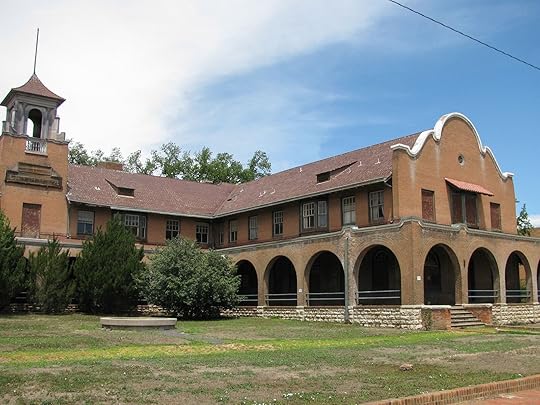
The property as seen from the rail-facing side before the restoration. Photo: Underawesternsky/Shutterstock
Bringing the Castañeda back to life was no small task, but worth the effort for the historical significance alone. The original 30,000-square-foot building was completed in 1898 under the direction of architect Frederick Roehrig. It was renowned travel magnate Fred Harvey’s first purpose-built trackside hotel. A wraparound porch fronts the building, while another covered area sits beside the courtyard near the tracks that once brought travelers West by train via the Santa Fe Railway that ran from Chicago to Los Angeles. (Today, it’s a stop on the Amtrak Southwest Chief Line.)
Old black-and-white photos from the hotel’s past show how close the restoration brought the Castañeda to its state in the glory days. The bar, rightfully, is now far from anything that could be called “Nasty Casty.” The Castañeda is in good company as far as preservation is concerned: It sits in a registered historic district filled with 1800s-era buildings. Las Vegas has more than 900 buildings on the National Register of Historic Places, or about one for every 14 residents.

Photos: Nickolaus Hines
The pandemic partially closed the Castañeda shortly after it reopened. A few employees stayed to keep the operation running — film contracts for shows like Amazon’s Outer Range, shot in Las Vegas, meant there was still some business even when most areas of life shut down. Or at least enough people to keep fresh ghost stories coming in.
After we got our keys, my mom gently, but firmly, requested the keys to both rooms so that she could see if everything was okay spirits-wise. (Let’s just say I grew up familiar with the smell of burning sage and the atmosphere of spiritual readings.) I stayed downstairs to chat more with the man at the front desk. He grew up in Las Vegas and helped with the Castañeda reopening, so he’d heard his fair share of stories.

Photo: Nickolaus Hines
In 2014, a crew from the Travel Channel show Ghost Adventures came to investigate and spotted something going down the staircase that led to the rooms. In another case, a musician swore to the receptionist that he heard repeated sounds and old-time music from the room across the hall — that room, and the others next to it, was empty. Many ghost stories revolve around a woman in early 1900s formalwear hovering between the kitchen exit and the staircase. During a slow period at the height of the pandemic, the receptionist heard what sounded like a phone dropping on the second floor. He ran up with a flashlight ready to defend himself, but no one was there.

Photos: Nickolaus Hines
I’m certainly not the type of traveler to seek out allegedly haunted places — especially with a toddler in tow. That said, I do find the stories entertaining and I (mostly) don’t go out of my way to avoid possible confrontations with the supernatural. Stories were thankfully all we got at the Castañeda. The rooms are large and comfortable with a vintage charm, and the location is walkable. It wasn’t until later, when I dug into the non-paranormal history of the property that I found the most interesting stories about what makes the Castañeda special.
The central role Fred Harvey’s Castañeda played in the golden age of rail travelRailroads made long distance travel easier than ever before in the 19th century, but it was not kind to hungry stomachs. Many trains lacked dining cars, and the few stops trains made were too short for even the unappetizing food available at lackluster lunchrooms not equipped to handle a rush of customers who all had a designated time to order, eat, and pay before rushing back to their train or be left behind.
This was the world before Fred Harvey. Harvey was born in England and moved to New York when he was 15. In 1858, he opened a restaurant in St. Louis that left Harvey broke just a few years later after his partner joined the Confederacy in 1861. He transitioned to the corporate world of rail travel and eventually moved to Leavenworth, Kansas, which became his permanent home town.
It wasn’t until 1876 that he landed on a winning business idea with the Fred Harvey Company.
Harvey struck a handshake deal with the Atchison, Topeka & Santa Fe Railroad in 1876 to open the first Harvey House restaurant in Topeka, Kansas. The clean atmosphere, quick service, and quality food — far from givens for people traveling west in those days — was a hit. He added a hotel in 1877 and a hotel-restaurant in 1878. A Harvey business sat at about every 100 miles along the Santa Fe line by the 1880s, and Harvey became known as the “Civilizer of the West.”
The moniker was in no small part thanks to the “Harvey Girls” — young women from the East and Midwest who had to follow high standards in both appearance and social interactions. The women were prohibited from marrying, though they received a wage, free room and board, and relative financial stability for a time when women were largely kept out of the workforce, particularly in the Wild West where merely living in a frontier town could tarnish a woman’s reputation. They were well loved, and even got an MGM musical, The Harvey Girls starring Judy Garland, in 1946.
Among the many properties, the Castañeda stood out for its level of luxury, but also its style. It was the first Harvey property built from the ground up to adhere to the Spanish mission style architecture that’s now synonymous with the Southwest — Las Vegas was once the biggest community in the Southwest and carried a level of influence. The Alvarado Hotel in Albuquerque followed the Castañeda’s design in 1902 (and helped inspire an historic preservation movement in New Mexico when it was demolished in 1970). The Fred Harvey Company portfolio became not just one of the first businesses travelers encountered as they traveled West, they became a defining feature of the Southwest as a whole. That was in no small part thanks to the embrace of the Spanish-influenced architecture that, for Harvey, started with Castañeda.
Harvey died in 1901, not long after the Castañeda opened, and his sons Ford and Byron took over the family business. Trains got faster and took fewer stops through the 1910s and ‘20s. New highways started to become the make-or-break economic driver of towns rather than a rail station. That only got worse after World War II and the start of the international highway system. As highways replaced railroads as the dominant mode of travel, the Fred Harvey Company created a car-focused business with “Indian Detours” that had drivers and guides shuttling travelers in luxury cars to areas they could purchase Native American jewelry, pottery, and crafts.
It was an era of managed decline. Historic Route 66 skipped Las Vegas by a few miles, making it a detour to stay at places like the Castañeda. Some Harvey properties set apart from the rail survived, like El Tovar and Bright Angel near the Grand Canyon and La Fonda in Santa Fe, but most others fell into disrepair and were eventually demolished. The former travel empire crumbled and businesses that once helped shape westward travel were demolished. Today, only a few remain.
Harvey may not be a household name today, even for those who love travel, but he maintains a following. The annual Fred Harvey History Weekend that takes place in Santa Fe, and books out Harvey hotels the hour or so out to Las Vegas as well, is in its 16th year.
An historic site with a presidential past
Teddy Roosevelt riding the train through the Southwest. Photo: Everett Collection/Shutterstock
The Castañeda opened in time to host the first Rough Riders Reunion in 1899, one year after the end of the Spanish-American War. Veterans and Theodore Roosevelt himself, then the governor of New York and two years away from the presidency, arrived by train for a three-day reunion celebration. The volunteer cavalry unit was filled with men from the Southwest. A fancy new hotel in New Mexico where many were from made natural sense for the reunion location.
Newspaper ads for the Rough Rider reunion promoted round-trip train tickets for $26.10 — the equivalent of more than $3,800 today. The event was viewed as a one-year anniversary of the Rough Riders, but also a showcase for New Mexico itself, with Las Vegas at its heart.
Subsequent Rough Rider reunions happened each year in Las Vegas. A photograph from the 1899 event shows a packed crowd gathered to see Roosevelt and the Rough Riders, and other images from the event were in our rooms. These had the standard old-sepia-photo haunted vibe with blurry subjects in certain areas from the camera technology available at the time (probably).
In the modern era, Roosevelt fans are still drawn to history tours in the town, judging by the multiple older couples and groups I saw in the Castañeda lobby dressed in classic tourist gear.
I overheard them talking about what they’d seen and what Roosevelt stops were still upcoming, and I asked a few people if there had been any supernatural Roosevelt-related sightings. Nothing so far, one man said, then lifted the binoculars hanging from his neck and jokingly scanned up the staircase from the check-in desk. But hey, he still had a few nights at the hotel and plenty more places to see. 
The Best Street Food You Can Eat Across Central America

Hot take: Street food is a better way to gain an understanding of the culinary chops of a city than its fine dining establishments. Bonus, it’s also much more affordable. This is particularly true in Central American countries, where seasonings like cilantro, achiote, garlic, and citrus define cuisines that differ greatly from their counterparts to the north and south. Dishes from Guatemala south to Panama impart strikingly bold and vibrant tastes. Grilling (asado), frying (frito), and steaming (especially for tamales) are popular methods of preparation, while many dishes uniquely combine savory and sweet elements, such as the pairing of plantains with beans and cheese.
Dishes you’ll find vary not only by country but often by region or city. To find the best meal, employ tips that may counter your typical process when sourcing your next meal. Look for the place with the line of locals. A busy street food stall indicates two things: First, that the stall is popular with residents, often signaling they eat there often (and therefore, it must be awesome). Second, it greatly increases the likelihood that the food is fresh, as the supply is burned through quickly.
Matador spoke with chefs and influencers from around the region, combined with the experience of team members, to identify the top dishes beyond arroz con pollo (chicken with rice) to try and excellent vendors who prepare them, from the markets to the street corners.
Street food to try in El Salvador
Photo: Elloria Voltan /Shutterstock
Kevin El Cehve (@kevinelcheve) is a Salvadoran chef now based in Texas who has popularized local dishes like Arroz Aguado con Pollo and Cheese and Garlic Pupusas via his Instagram and TikTok channels along with his website. His first rule of thumb when traveling through El Salvador is to walk by the markets, stopping to sample what pulls you in. At Mercadito de Merliot, he notes, “you can also find other street food like fried tortillas with cheese and amazing soups like sopa de gallina.”
“You can throw a rock and hit a pupuseria in El Salvador,” he says.
However, the town of Olocuilta, south of the capital San Salvador, is known for its pupusas, Kevin notes. “It’s what we do best and are most known for,” he says. “Although they’re very affordable, it’s a labor-intensive dish that includes corn masa stuffed with whatever you want – cheese, chicharon, beans, loroco (sharp tasting flower which is a Salvadoran delicacy). The toppings are endless but these are the most common for Salvadorans. From street vendors to restaurants. If you hear sizzling it’s probably pupusas on a comal.”
He also recommends Nuegados de yuca, a sweet and savory treat that’s made with yucca root shredded and blended with Salvadoran cheese, fried and topped with honey made from raw cane sugar. Another must-try is Pan con Pollo.
“Or as we call it where I’m from in Ilobasco, Panes Rellenos,” Kevin says. “Slow roasted chicken with a savory, spicy sauce topped with watercress, tomato, cucumber, and whatever veggies you like. It’s easily my favorite sandwich. It’s very common to eat during the holidays like Christmas but it’s so beloved you can find many vendors or small restaurants sell it all the time.”
Other popular dishes:
Chory: What many people wouldn’t guess about El Salvador, Kevin says, is the popularity of sandwiches and hot dogs, known locally as a chory. “It’s a big part of what we eat,” he says. “They’re not like any type of sandwiches or hot dogs you’d find in the states.” The dish consists of a fried dog, topped with mayo, ketchup, pickled onions, and often times, hot sauce. Elote Loco, or “crazy corn,” consists of grilled corn topped with mayo, Salvadoran cheese, mustard, salsa roja (tomato-based), and negrita (a Worcestershire-based sauce). Finally, be sure to try yucca and chicharon, made with thick cuts of fried chicharon that’s crispy outside and soft inside.Panes mataniños: This sandwich translates to “the child killer.” This sandwich is a long hoagie topped with either ham, ground beef, or soy, pickled slaw, mayo, mustard, ketchup, and grated Salvadoran cheese on top, and is super common throughout the streets of San Salvador. “It’ll probably put you on your back if you eat too many,” Kevin says.Yucca and chicaron. “The yucca is either boiled or fried,” Kevin notes. “We typically top this with a pickled slaw of cabbage, carrots, jalapeno, onions and a lot of lime. A tomato sauce is drenched on top to give the dish that extra kick.”Street food to try in Guatemala
Photo: Jose Recinos /Shutterstock
Chef Karla Alonzo gained acclaim for bringing iconic recipes from her native Guatemala to her restaurant in Washington, DC, Maltiox.
“I’m from the east coast and we usually eat iguana en pulique, revolcados, Pepián, and kaq kik,” says Alonzo.”
Pepián is a thick, spicy, stew typically made with chicken, beef, or pork (or a combination of these). It’s known for its complex, slightly smoky flavor, which comes from roasted ingredients and ample dried chilies.
Of course, iguana isn’t in the repertoire of the typical American traveler. Not to worry, as Alonzo offers additional recommendations.
“What I recommend is to try the food on the streets or flea markets – that’s where you’re gonna find the real taste of the gastronomy of my country,” Alonzo says. “Try Shucos, which is our hot dog. And in the season of holy week I recommend to try the Tashmoo Patin. Also the Moyetes, buñuelos they are a seasonal dessert that we usually eat during holy week.”
The former is a pre-Columbian dish made of stone ground tomatoes turned into a sauce. The Moyetes consist of white bread with refried beans, cheese, meat, and a sauce to garnish.
Matador/em> newsletter guru Kelsey Wilking spends part of the year in Guatemala, and recommends the following:
Shucos: Especially at Dónde Chemita in Atigua.Tostados: In Guatemala City, stop into a small tostado shop and eat the specialty, she recommends. Shaved ice with mangoes: If you head to Lake Atitlan, Wilking recommends trying shaved ice with mangoes to match the sweet vibes of the scenery around you.Street food to try in Honduras
Photo: Manuel Chinchilla /Shutterstock
Eating street food in Honduras is the best way to experience the influence of Indigenous, African, and Spanish cultures on the country’s cuisine. Dishes here often feature staples like corn, beans, cheese, and meat. One of the most iconic street foods is the baleada, a soft, thick flour tortilla filled with refried red beans, crumbled cheese, and a dollop of sour cream. Often, it’s enhanced with scrambled eggs, avocado, or mea – so you’ll get your protein fix, as well.
Pastelitos, deep-fried turnovers stuffed with seasoned ground beef, rice, or potatoes, are a must-try on a busy day of sightseeing or active adventure. These are typically served with a side of pickled cabbage and hot sauce. Tajadas, fried plantain slices topped with ground beef, cabbage, and a drizzle of tomato sauce, are also popular and deliciously crunchy.
The Tegucigalpa and San Pedro Sula markets are excellent areas to try these dishes. At these markets (and others throughout the country’s cities and hub towns) vendors often line the streets, the most popular among them having a line through much of the day and into the evening. The Mercado Guamilito in San Pedro Sula is particularly famous for its baleadas and pastelitos, while the Parque Central de Tegucigalpa is a great spot to find vendors slinging tajadas and yuca con chicharrón.
Other common dishes:
Yucca con chicharrón: Like in El Salvador, yucca con chicharrón is common in Honduras, where fried yuca (cassava) is topped with crispy pork rinds and served with cabbage slaw and tomato sauce.Montucas: Tamales filled with corn and meat, wrapped in banana leaves, and steamed, are local go-tos.Sopa de caracol: Conch soup and ceviche are common along the country’s Caribbean coast.Rosquillas en miel: Corn doughnuts soaked in a sweet panela syrup, are common for dessert.Street food to try in Costa Rica
Photo: AventuraSur.photo /Shutterstock
In Costa Rica, “sodas” are common – though the term doesn’t refer to a carbonated beverage. Sodas are small, family-run restaurants common along the sides of highways, street corners, and beach towns throughout the country. The author of this story traveled coast to coast across Costa Rica and sampled street food in Puerto Viejo and Limon on the Caribbean coast, Alajuela and the capital of San Jose in the center of the country, and Puntarenas and Jaco on the Pacific coast.
Across all locations, Gallo Pinto was a standout. The name translates to “Spotted Rooster” and the dish is often considered Costa Rica’s “unofficial” national dish. I ate it most commonly for breakfast with eggs, though it’s possible to order Gallo Pinto throughout the day in many places. The primary ingredients include day-old white rice, black beans simmered with onions, garlic, red bell pepper, and cilantro, and a generous splash of Salsa Lizano, a quintessential Costa Rican condiment that adds a tangy, slightly smoky flavor. The beans are combined with the rice and cooked until the flavors meld. This is also what gives Gallo Pinto it’s name – it appears speckled once the rice and beans conjoin into one. A side of mayo is common with the dish.
Other common dishes:
Chifrijo: a bowl of rice topped with red beans, chicharrón, fresh pico de gallo, and avocado, often served with tortilla chips and lime wedges.Chorreadas: sweet corn pancakes made from ground fresh corn, typically enjoyed with a dollop of sour cream. Patacones: twice-fried green plantain slices served with black bean dip or chimichurri sauce, are another favorite, especially in beach towns and city markets.Arreglado: a crunchy, toasted sandwich filled with shredded beef or pork, lettuce, tomatoes, and a spicy sauce, commonly found at street vendors and sodas.Vigorón: a plate of boiled yuca topped with crispy pork rinds and a cabbage saladCasado plates: These combine rice, beans, salad, plantains, and a choice of protein like grilled chicken or fish, offering a well-rounded and affordable meal.Street food to try in Nicaragua
Photo: Will Ullmo /Shutterstock
Like other countries in the region, Nicaraguan street food blends indigenous, Spanish, and Afro-Caribbean influences. The ingredients typically include staples like corn, yuca, plantains, pork, cheese, and fresh vegetables, often seasoned with a mix of local herbs and spices. You’ll commonly find vendors along busy pedestrian thoroughfares in cities as well as in markets and along the coast in beach towns.
Vigorón: Boiled yuca topped with crispy pork rinds (chicharrón) and a tangy cabbage salad, often served on a banana leaf.Nacatamal: A traditional tamale made from corn masa filled with pork, rice, potatoes, peppers, and onions, wrapped in plantain leaves and steamed.Quesillo: A soft, chewy tortilla filled with cheese, pickled onions, and a splash of sour cream, typically served wrapped in a plastic bag.Tajadas: Fried green plantain slices served with fried cheese and cabbage salad.Baho: A hearty dish made with beef, green plantains, yuca, and cabbage, slow-cooked and served together.Rondón: A soup made with fish or meat, coconut milk, like yucca or taro, and plantains, common along the coasts.Street food to try in Panama
Photo: Steph Couvrette /Shutterstock
Panamanian street food draws similar influence to its regional neighbors, though in grand cases the result is a strikingly different dish. In Panama City, some of the most popular street food spots can be found at the Mercado de Mariscos, a bustling fish market where vendors offer freshly prepared seafood dishes and snacks. Food trucks and small stalls are also prevalent throughout the city, especially in areas like Casco Viejo and along the Cinta Costera.
Empanadas: Fried or baked pastries stuffed with beef, chicken, cheese, or fish, often enjoyed with a side of spicy sauce.Carimañolas: Deep-fried yuca dough filled with ground beef, chicken, or cheese, crispy on the outside and soft inside.Hojaldres: Fried bread made from a simple dough, often served with cheese, sausage, or eggs for breakfast.Patacones: Twice-fried green plantain slices, typically served as a side dish or snack, sometimes topped with shredded meat or cheese. More like thisFood + DrinkAll the Empanadas in South and Central America You Need to Try Before You Die
More like thisFood + DrinkAll the Empanadas in South and Central America You Need to Try Before You Die
Holland America Line Just Set a Record For the Longest Sushi Roll Made on a Ship. It’s Bigger Than You’re Thinking.

To mark the debut of its newest culinary offering, Holland America Line believes it has set a record on March 30 for the longest sushi maki roll made at sea with an approximately 90-foot-long roll aboard the line’s ship Rotterdam. For perspective, that’s a little under a tenth of the total length of the ship it was made on. Created by chef Masaharu Morimoto and more than 50 members of the ship’s culinary team, the colossal roll used more than 55 pounds of sushi rice and 33 pounds of fresh big eye tuna.
The feat was an obvious a photo opportunity and part of the launch of “Morimoto By Sea Sushi Bar,” a new specialty venue that will roll out across five Holland America ships through June 2025. The sushi bars, curated by Morimoto as part of his role as the cruise line’s Global Fresh Fish Ambassador, reflect the next phase in Holland America’s growing emphasis on fresh, high-quality seafood and chef-driven dining experiences.
Building on the popularity of the existing “Morimoto By Sea” restaurant and the pop-up experience on Nieuw Amsterdam, which started in 2023, the new bars will debut aboard Rotterdam, Koningsdam, Nieuw Statendam, and Eurodam. Each venue features an intimate counter with seating for 12, along with adjacent table seating.
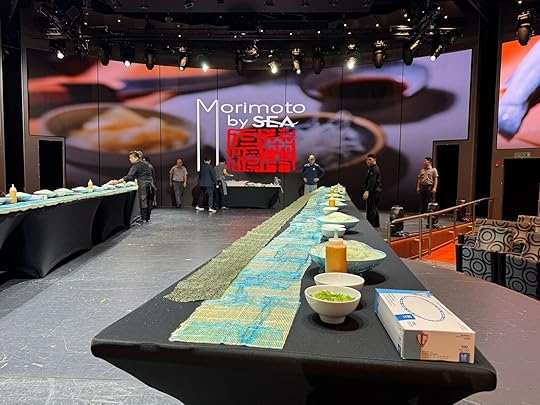
Photo: Holland America Line
Operating on an à la carte basis with an added surcharge, the bars will serve a seasonal selection of sushi and sashimi alongside a menu of Morimoto’s signature dishes like tuna pizza, pork gyoza dumplings, angry lobster pad Thai, and white chocolate lime ganache.
The sushi bars also reinforce the line’s Global Fresh Fish program, which sources seafood locally and serves it onboard within 48 hours. This focus on freshness and regional ingredients positions Holland America to compete in the increasingly sophisticated onboard dining landscape, especially in seafood-rich itineraries across Alaska, Japan, and the Mediterranean.
Reservations for the Morimoto By Sea Sushi Bar are available both before embarkation and onboard. The experience is part of Holland America’s broader strategy to enhance specialty dining while offering guests new, curated experiences anchored by culinary credibility. 
Bali Just Made ‘naughty’ Tourist Behavior Like Cursing Illegal

An incredibly popular tropical island known for Instagram influencers, digital nomads, and international yoga and wellness programs just introduced new laws to cut down on what it considers bad tourist behavior. And the new rules are about as strict as they come.
On March 24, 2025, the governor of Bali, in Indonesia, issued a new set of rules outlining seven types of acts now prohibited by visitors to the island. It’s an update of a set of behaviors outlined in 2023, but includes more details and information on enforcement, as well as a new focus on ensuring visitors pay a mandatory tourist tax. The list of banned behaviors for tourists includes:
Entering sacred temple areas unless worshipping and wearing traditional Balinese attire (menstruating women are prohibited)Climbing sacred trees or monumentsLitteringUsing single-use plasticsDisplaying any aggressive or disrespectful behavior, including swearing or sharing hate speech on social mediaWorking without proper permitsParticipating in illegal activities, such as buying and selling drugs. (Also illegal for residents, of course.)The law also includes a robust enforcement system, with Governor Wayan Koster ensuring the public that the rules will be “strictly enforced” with the use of a new police team. There’s even an official WhatsApp hotline where the public can report instances of tourists breaking the rules. The consequences for tourists who break Bali’s new rules can vary depending on the severity of the violation. Punishment could range from no more than a strict warning from police and order to correct the behavior to expulsion from tourist sites, monetary fines, possible jail time, or full deportation. Koster told Balinese media “foreign tourists who are naughty will be immediately dealt with firmly.”

The new law is also focused on ensuring more of Bali’s tourists pay the mandatory visitor tax. Photo: AsiaTravel/Shutterstock
The new law also reinforces an existing regulation that visitors pay a tourist tax. It’s a fairly reasonable rate of 150,000 Indonesian rupiah (around $9), but is one many tourists fail to pay. The Civil Service Police Unit (Satpol PP) will actively run checkpoints at popular tourist sites, says Koster, to ensure higher rates of tax compliance. The fee is used for projects on the island related to cultural preservation, environmental protection, and infrastructure improvements. Though it was introduced in February of 2024, data from the first year showed that only about one-third of visitors actually paid the tourist tax.
While the new law does add further specifications to the rules around work permits, it’s not expected to impact the island’s many digital nomads. Towns like Canggu and Ubud are extremely popular with the remote work set, many of whom are drawn to extended stay remote working accommodations in the laid-back towns. The process for getting a “Remote Worker Visa, officially known as an E33G visa, is unchanged, allowing digital nomads to stay for up to one year with the option to renew for up to five years. 
10 Remote Jungle Treehouse Airbnbs Under $200

I was raised in a house hidden in a forest in Scotland. My Swallow and Amazons-style upbringing of lazy days on homemade river rafts and overnight campouts in treehouses was idyllic. I often find myself craving the sense of adventure of yesteryears. Waking up surrounded by bird song high in the trees is just the medicine we all require — especially in today’s climate. If you’re seeking an unplugged retreat, there’s a lovely selection of treehouse Airbnbs that will immerse you in nature without costing an arm and a leg. From the mist-shrouded cloud forests of Costa Rica to the secluded bamboo dwellings in Bali’s rice fields, these remote treehouse Airbnbs are worth bookmarking. Whether you’re drawn to the treehouse with panoramic views of Oaxaca’s coastline, the hideaway near Thailand’s Mae Wang National Park, or the lush rainforest retreats in Brazil, these properties, all under $200 per night, offer a chance to disconnect and (re-)engage with the outdoors.
We hope you love the Airbnb jungle treehouse rentals we recommend! Just so you know, Matador may collect a small commission from the links on this page if you decide to book a stay. Listed prices are accurate as of the time of publication.
Luxury treehouse dome in Monteverde, Costa Rica Photo: Airbnb
Photo: Airbnb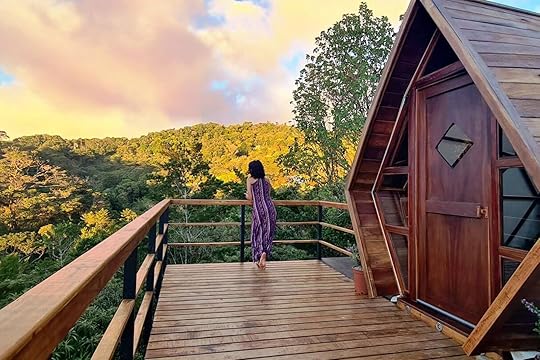 Photo: Airbnb
Photo: Airbnb Photo: AirbnbSee more photos
Photo: AirbnbSee more photosAlong Costa Rica’s continental divide, Monteverde’s cloud forests offer a haven from the country’s beach scene. Some might argue that you must choose between a coastal vacation or the forest, but you can do both. Splitting your time between the two environments will allow for chilled beach days and an opportunity to stay in one of the most biodiverse places on the planet. Monteverde is a sanctuary for wildlife. It’s home to endemic species such as the resplendent quetzal, jaguars, mantled howler monkeys and a dizzying array of flora and fauna hidden under the mist-covered forest canopy. Beyond the landscape and wildlife, the region is committed to sustainable practices. You’ll find many Airbnbs that are eco-friendly, and there are a bunch of community-driven tourism activities that offer you insight into the delicate ecological balance that defines this remote forest.
At this treehouse dome, you’ll wake to birdsong in the cancopy, and you might even get a visit from a monkey or two. The deck offers stunning mountain views, and the snug one-bedroom is drenched in light. The setup is simple, but there’s no roughing it. There’s a small kitchen with an espresso machine, fridge, and mini grill, an inside luxe bathroom, and a separate sitting area and a covered hammock where you can read in peace if you visit during the rainy season.
Two guests, one bedroom
Price: $190 per night
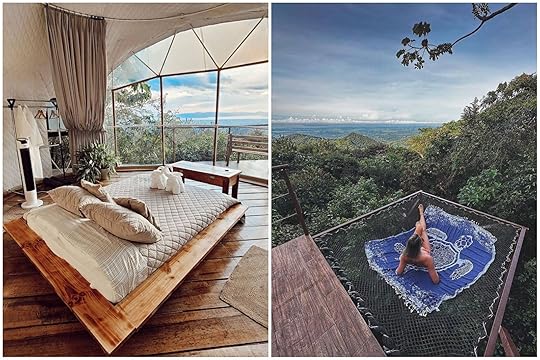 Photo: Airbnb
Photo: Airbnb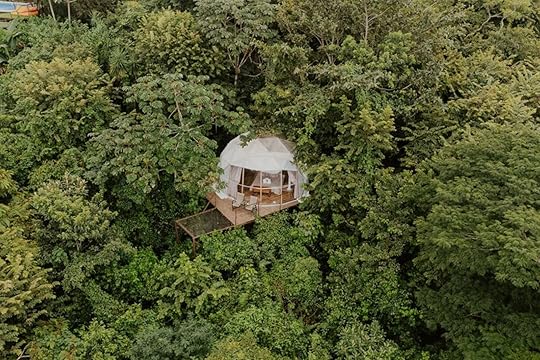 Photo: Airbnb
Photo: Airbnb Photo: AirbnbSee more photos
Photo: AirbnbSee more photosTajo Alto, a lesser-known highland region of Costa Rica, offers a more secluded experience than the well-established Monteverde. Situated at a slightly lower elevation, it retains the cloud forest characteristics but with a subtly warmer, more humid microclimate. This area, characterized by its steep, jungle-clad slopes and less developed infrastructure, provides a raw, unfiltered experience. It’s ideal if you’re looking for a more solitary immersion with the backing track of cascading waterfalls, bird song, and the rustling canopy.
For an affordable and memorable stay, this secluded geodesic dome, accommodating two guests, offers panoramic views of Puntarenas, the gulf, the Nicoya Peninsula, and the night sky. The dome features a double bed, a kitchenette equipped with an electric cooktop, refrigerator, and basic utensils, and a bathroom with a shower, plus an outdoor bathing area. Guests can also access a communal multi-level swimming pool, hammocks, and an open green space with a barbecue grill. The host can help you organize coffee plantation tours, canyon and mountain hikes, culinary tours, mangrove and Tortuga Island excursions, and zip-lining.
Two guests, one bedroom
Price: $196 per night
 Photo: Airbnb
Photo: Airbnb Photo: Airbnb
Photo: Airbnb Photo: AirbnbSee more photos
Photo: AirbnbSee more photosPunta Zicatela, a stretch of Oaxaca’s coastline, is quieter than the more frequented tourist paths of Mexico. This coastal strip south of Puerto Escondido is renowned for its surf, drawing experienced wave riders to its famous “Mexican Pipeline.” Accommodations on the coast are ideal for those who want to socialize. But, if you’d prefer to dip in and out of that scene, check out this epic treehouse, which, for under $200 per night, is an outrageous deal.
The sustainably built bamboo dwelling is situated on a hill overlooking Punta Zicatela and is the perfect retreat with panoramic ocean and mountain views. The accommodation includes a bedroom with a king-size bed and garden view, an open-plan sleeping area with a double bed and hammock, and two bathrooms. There’s a fully equipped kitchen, a private biopool with an outdoor shower, and amenities like high-speed Starlink WiFi, daily housekeeping, filtered drinking water, and a safety deposit box. The stay includes daily yoga classes led by a resident instructor, with optional cacao ceremonies and massage packages available for additional fees. The location offers proximity to restaurants and bars while being secluded, and airport pickup or transportation from previous accommodations can be arranged with the host.
Four guests, two bedrooms
Price: $178 per night
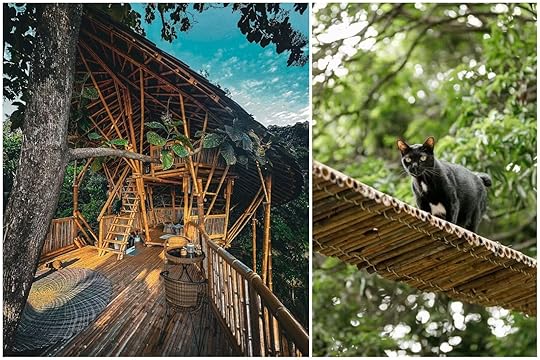 Photo: Airbnb
Photo: Airbnb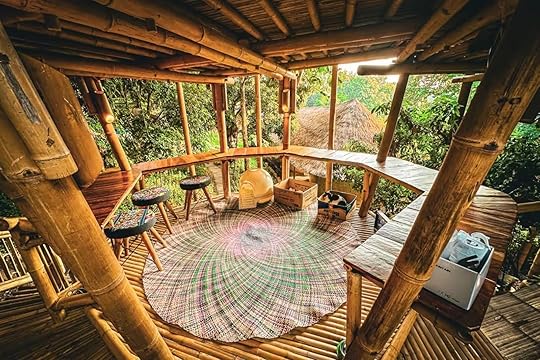 Photo: Airbnb
Photo: Airbnb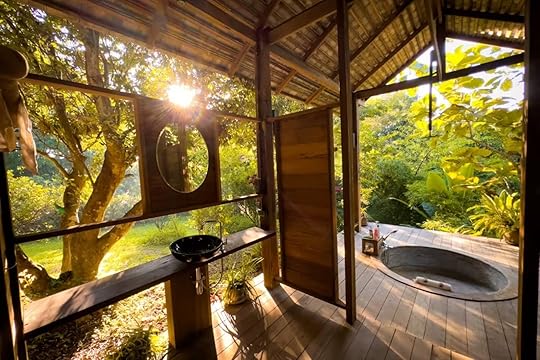 Photo: AirbnbSee more photos
Photo: AirbnbSee more photosThis secluded retreat sits on a private organic farm at the entrance of Mae Wang National Park (nicknamed “Thailand’s Grand Canyon”). The Mae Wang district provides a range of activities, with elephant camps, bamboo rafting, jungle kayaking, trekking, and hiking, alongside cultural sites such as Wat Luang Khun Win and Doi Inthanon, Thailand‘s highest peak. The wild Airbnb is purrfect for cat lovers. The farm is a sanctuary for 59 rescued stray cats. The three-story bamboo treehouse was designed by the architect of the Six Senses resort in Ko Kuud. The first floor has a work area equipped with high-speed internet; the second features a spacious terrace built around a teak tree, furnished with seating and a Bluetooth speaker. The third floor accommodates the sleeping area, using a tent during colder months and a mosquito net during warmer periods. There’s an outdoor bathroom, located a short distance from the treehouse with a rain shower and bathtub with mountain views. Guests can utilize a bamboo sala for relaxing afternoons and there’s a complimentary daily Thai breakfast. The host also has a Honda Wave 125 that you can rent to explore the area.
Four guests, one bedroom
Price: $198 per night
 Photo: Airbnb
Photo: Airbnb Photo: Airbnb
Photo: Airbnb Photo: AirbnbSee more photos
Photo: AirbnbSee more photosAnother option near Chang Mai is this luxury private treetop home with a converted helicopter in the main living area. The epic stay is in the Suthep district at the foot of Doi Suthep and is within walking distance of the religious temple of Baan Kang Wat. The wild “helipad” has two floors. The ground floor has a communal tropical garden, a small swimming pool, patio and deck lounge areas, and a luxe bathroom. A spiral staircase takes you to the second floor, where you’ll find a maze of interconnected rooms: a living and dining area with a vintage Huey helicopter and two bedrooms, one with a king-sized bed and a loft with an extra queen. Bedrooms are fully air-conditioned and bathed in natural light from skylights and huge handcrafted windows.
Eight guests, two bedrooms
Price: $200 per night
 Photo: Airbnb
Photo: Airbnb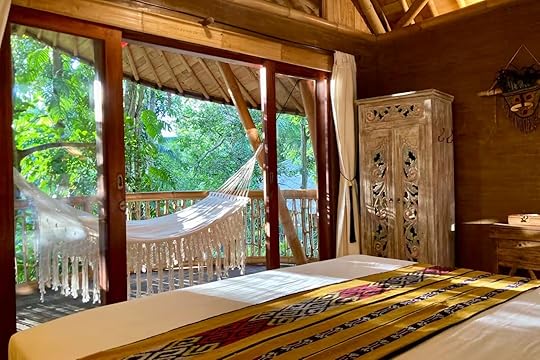 Photo: Airbnb
Photo: Airbnb Photo: AirbnbSee more photos
Photo: AirbnbSee more photosUbud is a very special place. If you were lucky enough to visit a decade ago, you would have had a very different experience from what you will have today. It’s become so popular that you need to make an effort to get off the tourist track and find a sanctuary away from the busy town streets and health food cafes overflowing with yogis.
For that, this bamboo eco-lodge will do nicely. It’s located in Lodtundu, a traditional Balinese village in South Ubud (around four miles from Ubud town). The village has retained the bohemian artist lifestyle many come to Ubud for, and you’ll find numerous galleries of painters, mask makers, and woodcraft shops within walking distance of the treehouse. The sustainably built home has a lovely bedroom, bathroom, and a spacious balcony where you can kick back with a morning coffee and a river view.
Two guests, one bedroom
Price: $94 per night
 Photo: Airbnb
Photo: Airbnb Photo: Airbnb
Photo: Airbnb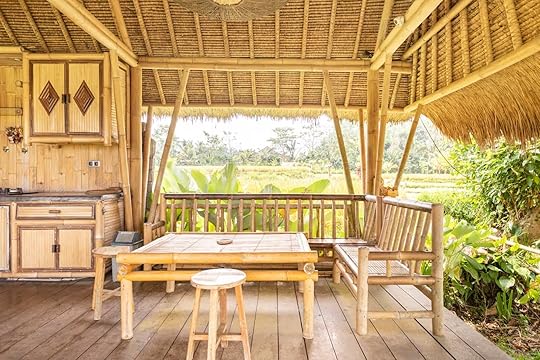 Photo: AirbnbSee more photos
Photo: AirbnbSee more photosTampaksiring, located northeast of Ubud, is a lot less touristy. The region is known for its sacred springs at the Tirta Empul temple, which you can visit to learn more about traditional Balinese rituals and spiritual practices. The landscape is peppered with rice terraces, and the dramatic cliffs of the Pakerisan River valley make Tampaksiring a very attractive alternative if you’re looking for a spiritual retreat in beautiful surroundings.
The charming bamboo treehouse is on a working rice field and offers 180-degree views of the surrounding countryside. The two-story structure features a downstairs relaxation area furnished with beanbags and an open-air bathroom, allowing for unobstructed views of the sky and coconut trees during showering. The upstairs bedroom has a queen-sized bed with a mosquito net and a private balcony. Guests have access to a communal kitchen that overlooks the rice fields and daily breakfast is included in the stay.
Two guests, one bedroom
Price: $49 per night
 Photo: Airbnb
Photo: Airbnb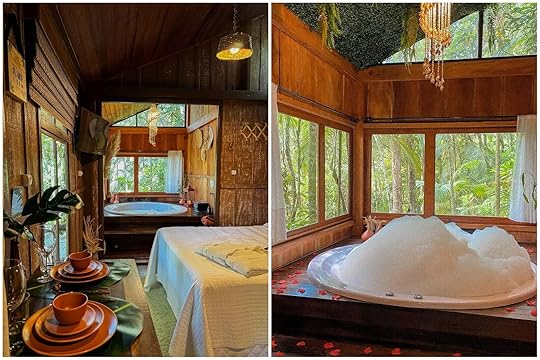 Photo: Airbnb
Photo: Airbnb Photo: AirbnbSee more photos
Photo: AirbnbSee more photosThere are a surprising number of treehouse Airbnbs in Brazil. This charming forest cabin is ideal for a romantic getaway for those who want easy access to outdoor sports and city amenities. The cabana is hidden in the forest, but it’s not far from the city of Gaspar in the Itajaí Valley of Santa Catarina. It’s the perfect place to hide away for a special occasion. The host includes celebrational decorations and a breakfast basket, and days (or evenings) can be whiled away in the indoor hot tub or outside on the netted day bed or balcony.
Two guests, one bedroom
Price: $120 per night
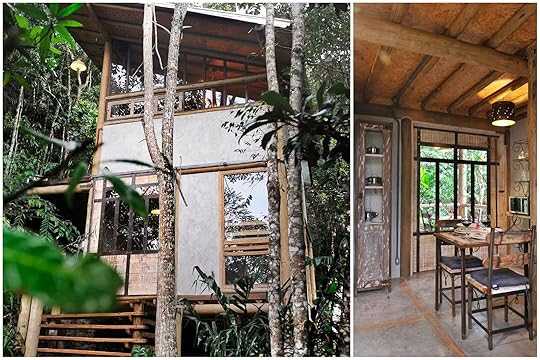 Photo: Airbnb
Photo: Airbnb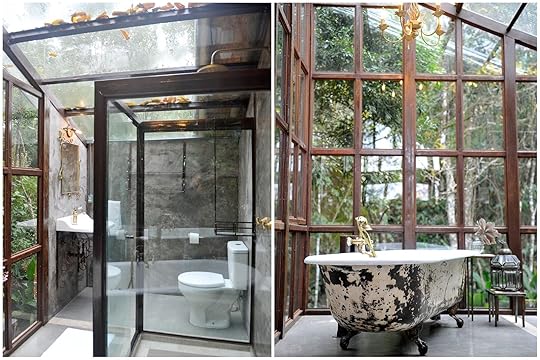 Photo: Airbnb
Photo: Airbnb Photo: AirbnbSee more photos
Photo: AirbnbSee more photosAnother great place to uplug away from Brazilian cities (but still close to town amenities) is this treehouse tiny home listing near Araras in the southeastern region of the country. The beautifully designed home is surrounded by waterfalls and greenery and has rave reviews from past guests. The home integrates with nature. Walls of glass bring the outside in, there’s a terrace and a gorgeous tropical garden, and the suite has a claw-foot bathtub that overlooks a waterfall and deck with a hammock.
Two guests, one bedroom
Price: $129 per night
 Photo: Airbnb
Photo: Airbnb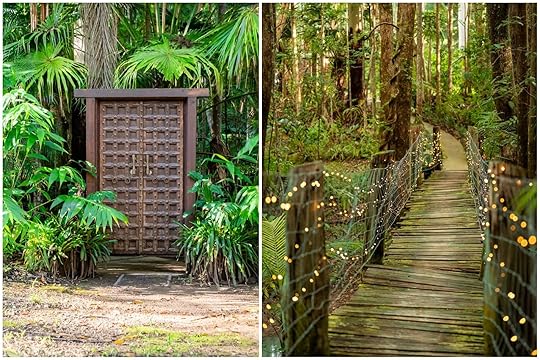 Photo: Airbnb
Photo: Airbnb Photo: AirbnbSee more photos
Photo: AirbnbSee more photosThis region of New South Wales is perfect for those who want to experience life on the coast (it’s not far from the laid-back surf town of Byron Bay) and in the forest. The rural community of Main Arm is a gateway to the Tweed Valley and Mount Jerusalem National Park, which is famed for its diverse ecosystems of eucalypt forests and subtropical rainforests. The park’s walking trails, creeks, and waterfalls support a variety of wildlife, including threatened species like Albert’s lyrebird and the red-legged pademelon, and provide opportunities for bushwalking, birdwatching, and horse riding.
Accessible via a rustic wooden bridge, the isolated retreat is set within a tropical oasis on a 24-acre property. The interior, designed with Balinese influences, features a fully equipped kitchen, a queen-sized bed with organic linens, and modern amenities, including air conditioning, a wood fire, and high-speed internet with streaming services. Outside, there’s a large deck and a double swing overlooking the creek, where you might spot a lazy goanna and hundreds of fireflies at night. 
Four guests, two bedrooms
Price: $186 per night
Matador Network's Blog
- Matador Network's profile
- 6 followers



